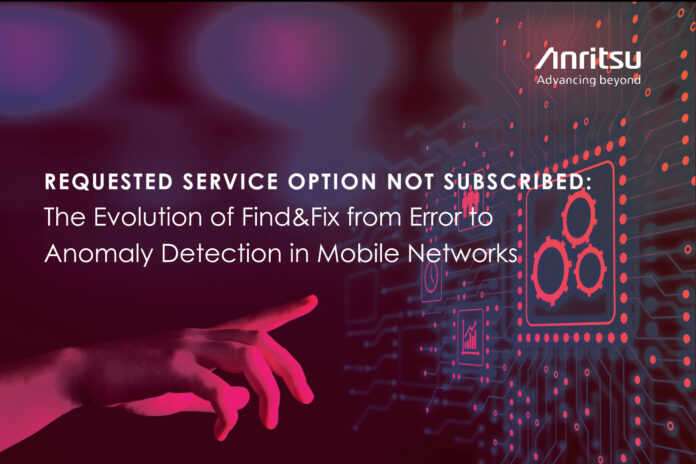Partner content: The evolution of Find&Fix – the journey from error to anomaly detection in mobile networks
€35 million – the staggering amount a counterpart at a large German red operator disclosed it saved annually 15 years ago by addressing Error 33: ‘Requested service pption not subscribed’. I was a product manager for a product with cutting-edge capabilities, handling any error detected on the network with a set of remedies, including over-the-air fixes, updates to provisioning systems, and even proactive care messages sent to subscribers.
What stood out was the solution’s efficiency; errors were detected and resolved in under two minutes. This rapid fix allowed misconfigured devices with, for example, Error Code 33 to access data, leading to fewer customer care calls, proactive problem resolution, and enhanced customer experience.
More complicated
However, the landscape of mobile network issues and their resolutions has significantly evolved from what now seem like simpler times. By fixing such errors on the network side, devices no longer started with this particular problem.
Many of the most serious subscriber-impacting errors that once plagued networks have been addressed and resolved. Yet, as valuable as these solutions were, the era of fixing singular network errors drew to a close. The low-hanging fruit had been picked, and with it, the method of detecting and resolving these issues needed to evolve.
The advent of anomaly detection marked a pivotal shift in how we approach network management and service assurance. Moving beyond the resolution of individual errors, the focus has now expanded to identifying patterns and anomalies across the network. This transition represents a profound change in strategy – from targeting specific error codes to uncovering the more complex issues that affect services and subscribers.
Timeliness
I want to give an example of the importance of timeliness. Garmin has a pretty cool feature on some of their watches. This feature detects for someone stationary if their heart rate exceeds a specific configurable value. As expected in this case, the watch owner is notified immediately.
It would be odd if the watch told the owner that this happened 30 or 45 minutes ago. Similarly here, anomaly detection is the only way to detect issues for subscribers close to real-time. Without it, if we use the metaphor from the watch, the patient may be dead.
With that, it’s important to understand that matching the efficiency and timeliness of the previous solution is more complex than it seems. Anomaly detection is looking at patterns and not singular errors. To get patterns for subscribers, you need to simultaneously look at issues across the whole subscriber base. To emphasise this point, for the previously mentioned operator above, this would mean seeing the errors, metrics, and issues for 30+ million subscribers simultaneously in real time so you can see the anomalies.
Doing complete subscriber-base anomaly detection in real-time is a challenge that requires some clever technology optimising for the right data quickly while at the same time being smart enough to understand the context of the telco time-series data.
Substantial benefits
However, this approach has some substantial benefits that separate it from before. With anomalies being a pattern, you can infer the root cause of the issue from the pattern. So, each case will come with a signature that can be stored, analysed and fingerprinted, ready for automation.
Anomalies will trigger a case for investigation, and with this comes enhanced meta-data, which is perfect for the initial stages of automation based on real-time subscriber experiences.
The implications of this shift are far-reaching. Anomaly detection allows for the identification of widespread and difficult-to-detect issues and facilitates quicker, more effective resolutions. By automating fixes, operations are streamlined, reducing the burden on customer care and improving the subscriber experience.
The benefits of this approach are potentially even more significant than those realised in the past, with automation playing a pivotal role in enhancing operational efficiency and customer satisfaction.
Drawing from my experiences in this industry, I’ve witnessed its progression from basic error rectification to today’s sophisticated subscriber-based anomaly detection. This evolution towards anomaly detection underscores the telecommunications industry’s shift towards more intelligent, automated systems capable of managing the complexities of modern networks.
Automated fixes
Today, I see many operators looking at automated fixes for their networks. The shift to automating fixes for subscriber-based issues is still maturing. For this shift to fully take, operators need to dedicate teams to an automation-first approach. What use is it having granular insight on small and large cohorts of subscribers in real-time if you do not have the operational bandwidth to address them?
Of course, the bigger anomalies, the ones that put the CTO’s job is on the line and newspapers report them, need fixing as fast as possible, so this two-minute resolution time is critical. But to tackle network issues and automate on the road to autonomous networks, you need to address subscriber issues like we did 15 years ago – address each one individually, in real time.
In essence, the story of the ‘Requested service option not subscribed’ error is a microcosm of the larger journey in telecommunications. It highlights the industry’s move from reactive, manual interventions to proactive, automated solutions, even if some were automated as far back as 15 years ago.
As we embrace AI, ML, and advanced analytics, the potential for even more robust, efficient, and customer-centric service assurance practices becomes increasingly evident.
Third phase of the journey
My German counterpart could speak about a business case of €35 million when finding and fixing errors 15 years ago. What impact and business case will be made when operations move to autonomous networks? Networks will be aware of their state, with an understanding of how to optimise based on many factors. So, for example, how can they balance requests for resources as they happen, with a keen eye on the experiences of subscribers, devices and corporate business?
This is the third stage in this journey and will take some time. It will build on anomaly detection and use advanced technology like AI and the buzzworthy GenAI. Let’s imagine a future in 15 years where Find&Fix is not taken care of by humans but by intelligent systems and where there is no more ‘Requested service option not subscribed’.
About the author
Matthew Twomey is Head of Marketing at Anritsu Service Assurance and a seasoned professional in this field, with over 25 years’ experience in the industry. He has a diverse background, having worked for companies such as Ericsson, Arantech, Tekcomms, The Now Factory, IBM and Mobileum, where he held various roles. They ranged from business consultant to product management, product marketing and marketing. With a wealth of knowledge and experience in the telecom industry, Twomey is passionate about understanding customers’ needs while driving success and growth.

About Anritsu Service Assurance – a division of Anritsu A/S and specialises in providing state-of-the-art network service assurance solutions. The division is committed to developing innovative technologies that empower businesses to enhance network performance, streamline service delivery, and deliver unrivalled customer experiences.


